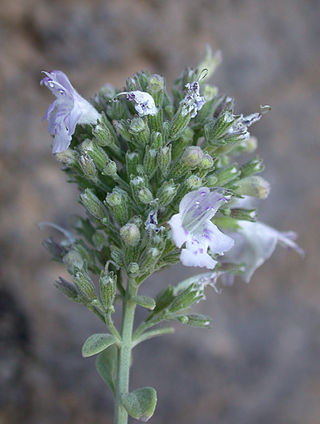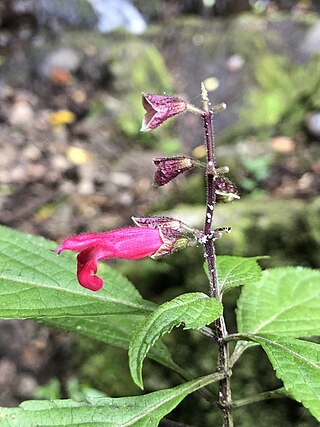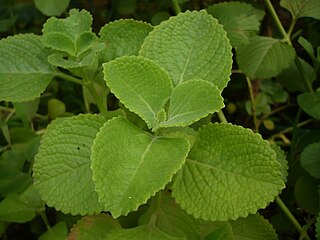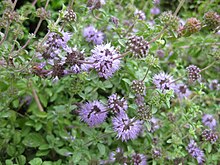
The Lamiaceae or Labiatae are a family of flowering plants commonly known as the mint, deadnettle or sage family. Many of the plants are aromatic in all parts and include widely used culinary herbs like basil, mint, rosemary, sage, savory, marjoram, oregano, hyssop, thyme, lavender, and perilla, as well as other medicinal herbs such as catnip, salvia, bee balm, wild dagga, and oriental motherwort. Some species are shrubs, trees, or, rarely, vines. Many members of the family are widely cultivated, not only for their aromatic qualities, but also their ease of cultivation, since they are readily propagated by stem cuttings. Besides those grown for their edible leaves, some are grown for decorative foliage. Others are grown for seed, such as Salvia hispanica (chia), or for their edible tubers, such as Plectranthus edulis, Plectranthus esculentus, Plectranthus rotundifolius, and Stachys affinis. Many are also grown ornamentally, notably coleus, Plectranthus, and many Salvia species and hybrids.

Satureja is a genus of aromatic plants of the family Lamiaceae, related to rosemary and thyme. It is native to North Africa, southern and southeastern Europe, the Middle East, and Central Asia. A few New World species were formerly included in Satureja, but they have all been moved to other genera. Several species are cultivated as culinary herbs called savory, and they have become established in the wild in a few places.

Micromeria douglasii, synonym Clinopodium douglasii, or yerba buena, is a rambling aromatic herb of western and northwestern North America, ranging from maritime Alaska southwards to California. The plant takes the form of a sprawling, mat-forming perennial, and is especially abundant close to the coast. The name "yerba buena" derives from Spanish for "good herb" and is applied to various other plants. In 2010, molecular evidence placed the species within the Clinopodium complex rather than Micromeria.

Salvia yangii, previously known as Perovskia atriplicifolia, and commonly called Russian sage, is a flowering herbaceous perennial plant and subshrub. Although not previously a member of Salvia, the genus widely known as sage, since 2017 it has been included within them. It has an upright habit, typically reaching 0.5–1.2 metres tall, with square stems and gray-green leaves that yield a distinctive odor when crushed. It is best known for its flowers. Its flowering season extends from mid-summer to late October, with blue to violet blossoms arranged into showy, branched panicles.

The Orchidoideae, or the orchidoid orchids, are a subfamily of the orchid family (Orchidaceae) that contains around 3630 species. Species typically have a single (monandrous), fertile anther which is erect and basitonic.

Monarda is a genus of flowering plants in the mint family, Lamiaceae. The genus is endemic to North America. Common names include bergamot, bee balm, horsemint, and oswego tea, the first being inspired by the fragrance of the leaves, which is reminiscent of bergamot orange. The genus was named for the Spanish botanist Nicolás Monardes, who wrote a book in 1574 describing plants of the New World.

Agastache is a genus of aromatic flowering herbaceous perennial plants in the family Lamiaceae. It contains 22 species, mainly native to North America, one species native to eastern Asia. The common names of the species are a variety of fairly ambiguous and confusing "hyssops" and "mints"; as a whole the genus is known as giant hyssops or hummingbird mints.

Clinopodium is a genus of flowering plants in the family Lamiaceae. It is in the tribe Mentheae of the subfamily Nepetoideae, but little else can be said with certainty about its phylogenetic position.

The Elymniini is one of the tribes of the subfamily Satyrinae. If the subfamily Satyrinae elevate to family status, this tribe shall be treated as subfamily Elymniinae. Elymniini was formerly a large group, but recently, it is considered to be include only one genus, Elymnias, according to molecular phylogenetic analyses.

Oxera is a genus of flowering plants in the family Lamiaceae native to Vanuatu and New Caledonia in the western Pacific.

Micromeria fruticosa, commonly known as white micromeria or white-leaved savory, is a dwarf evergreen shrub endemic to the eastern Mediterranean, as well as found in the Balkans. It is a member of the genus Micromeria, in the family Lamiaceae. It is known as zuta levana in today's Modern Hebrew and ashab a-shai in Arabic. The Bedouins, however, call it by the Arabic name, qurniyya, believed to be a cognate of the Hebrew qoranit, an aromatic herb described in the Mishnah. The plant's aromatic leaves are used in making decoctions.

Salvia is the largest genus of plants in the sage family Lamiaceae, with nearly 1000 species of shrubs, herbaceous perennials, and annuals. Within the Lamiaceae, Salvia is part of the tribe Mentheae within the subfamily Nepetoideae. One of several genera commonly referred to as sage, it includes two widely used herbs, Salvia officinalis and Salvia rosmarinus.

Corypheae is a tribe of palm trees in the subfamily Coryphoideae. In previous classifications, tribe Corypheae included four subtribes: Coryphinae, Livistoninae, Thrinacinae and Sabalinae, but recent phylogenetic studies have led to the genera within these subtribes being transferred into other tribes. Tribe Corypheae is now restricted to the genus Corypha alone.

Cryosophileae is a tribe of palms in the subfamily Coryphoideae. The tribe ranges from southern South America, through Central America, into Mexico and the Caribbean. It includes New World genera formerly included in the tribe Thrinacinae, which was split after molecular phylogenetic studies showed that Old World and New World members of the tribe were not closely related.

Salvia venulosa is a perennial plant that is native to a very small region of the Western Cordillera in Colombia. It grows at 1,500 to 2,000 m elevation in deeply shaded wooded gullies. S. venulosa grows less than 1 metre (3.3 ft) tall, with narrow ovate leaves that are 6 to 9 cm long and 3 centimetres (1.2 in) wide, and violet on the underside. The flower is an unusual wine-red color.

Dendrobieae is a tribe in the subfamily Epidendroideae, in the family Orchidaceae. The Dendrobieae are mostly tropical, epiphytic orchids which contain pseudobulbs.

Amaryllidoideae is a subfamily of monocot flowering plants in the family Amaryllidaceae, order Asparagales. The most recent APG classification, APG III, takes a broad view of the Amaryllidaceae, which then has three subfamilies, one of which is Amaryllidoideae, and the others are Allioideae and Agapanthoideae. The subfamily consists of about seventy genera, with over eight hundred species, and a worldwide distribution.

Coleus is a genus of annual or perennial herbs or shrubs, sometimes succulent, sometimes with a fleshy or tuberous rootstock, found in the Afro-Eurasia tropics and subtropics.

Borasseae is a tribe in the palm subfamily Coryphoideae. The tribe ranges from southern Africa and Madagascar north through the Arabian Peninsula to India, Indochina, Indonesia and New Guinea. Several genera are restricted to islands in the Indian Ocean. The two largest genera, Hyphaene and Borassus, are also the most widespread.

Nepetoideae is a subfamily of plants in the family Lamiaceae.




















